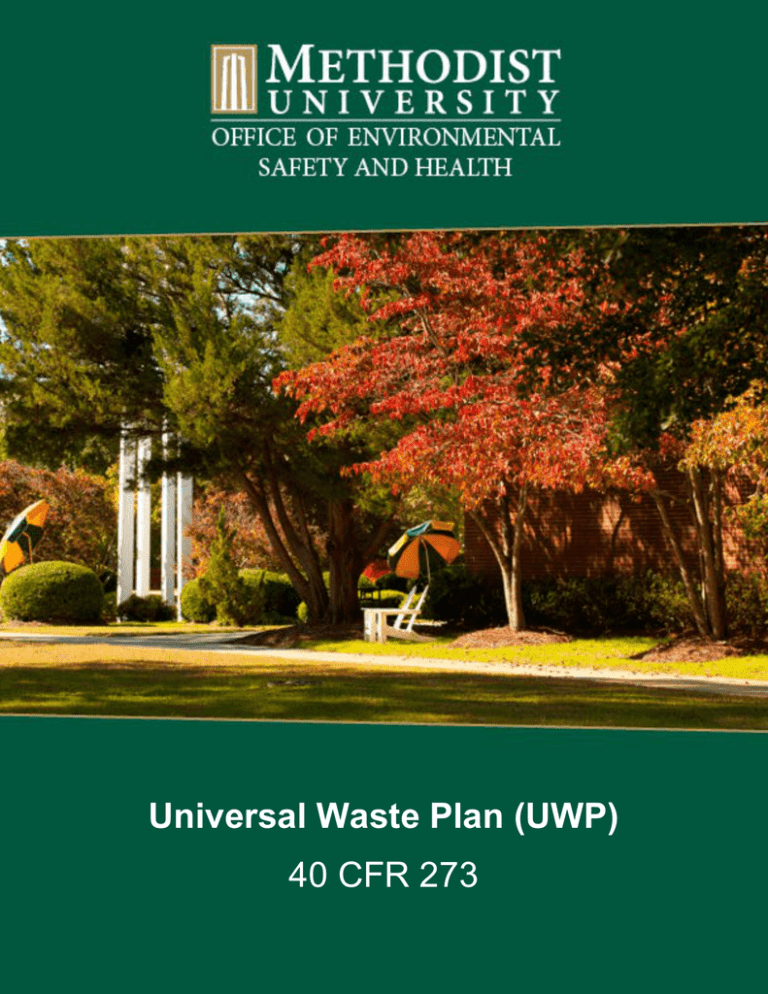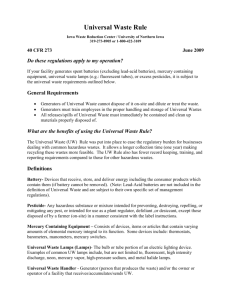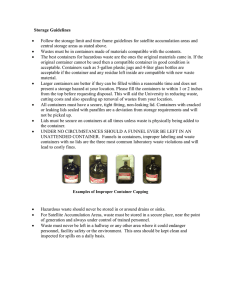Universal Waste Plan (UWP) 40 CFR 273
advertisement

Universal Waste Plan (UWP) 40 CFR 273 METHODIST UNIVERSITY OFFICE OF ENVIRONMENTAL HEALTH & SAFETY METHODIST UNIVERSITY Environmental Health and Safety Office Universal Waste Plan (UWP) 40 CFR 273 – Standards for Universal Waste Management Revision 5 September 2013 Estimated time to review: 60 – 90 minutes Review of this document needs to be completed prior to working with or handling any universal waste on campus. Universal Waste Plan Page 1 METHODIST UNIVERSITY OFFICE OF ENVIRONMENTAL HEALTH & SAFETY DOCUMENT REVIEW LOG September 13, 2013…………………….……….……………… Annual Update by Blackley January 16, 2012……………………………..……….………… Annual Update by Blackley January 31, 2012……………………………..……….………… Annual Update by Blackley January 31, 2011……………………………….……...… Annual Update by Raineri-Padilla January 11, 2010………………………………………….Annual Update by Raineri-Padilla January 14, 2009…………….……………………………...……Original Document Created Universal Waste Plan Page 2 METHODIST UNIVERSITY OFFICE OF ENVIRONMENTAL HEALTH & SAFETY Table of Contents 1.0 General Information ............................................................................................ 4 2.0 Location and Description of the University ...................................................... 4 3.0 Policy Statement.................................................................................................. 5 4.0 MU Universal Waste Handler Status .................................................................. 5 5.0 Responsible Parties with Title Designations .................................................... 5 6.0 Definition of Hazardous Waste ........................................................................... 5 6.1 Universal Waste Batteries – [40 CFR 273.2] ................................................... 6 6.2 Universal Waste Pesticides – [40 CFR 273.9]................................................. 6 6.3 Universal Waste Mercury Containing Equipment - [40 CFR 273.4] .............. 6 6.4 Universal Waste Lamps – [40 CFR 273.9 (c)].................................................. 6 7.0 Handling of Universal Waste .............................................................................. 6 8.0 Labeling of Universal Waste ............................................................................... 7 8.1 Labeling of Universal Waste Batteries ........................................................... 7 8.2 Labeling of Universal Waste Pesticides ......................................................... 7 8.3 Labeling of Universal Waste Mercury Containing Equipment ..................... 7 8.4 Labeling of Universal Waste Lamps ............................................................... 7 9.0 Universal Waste Container Requirements ........................................................ 7 9.1 Battery Containers ........................................................................................... 8 9.2 Pesticide Containers ........................................................................................ 8 9.3 Mercury Containing Equipment Containers .................................................. 8 9.4 Lamp Containers .............................................................................................. 8 10.0 Universal Waste Accumulation Areas ............................................................ 9 11.0 Proper Disposal................................................................................................ 9 12.0 Universal Waste Management......................................................................... 9 12.1 Waste Management-Batteries ...................................................................... 9 12.2 Waste Management-Pesticides.................................................................... 9 12.3 Waste Management-Mercury Containing Equipment .............................. 10 12.4 Waste Management-Lamps ........................................................................ 10 13.0 Personnel Training – [40 CFR 273.16] .......................................................... 10 14.0 Recordkeeping and Recording ..................................................................... 10 15.0 Definitions....................................................................................................... 10 Universal Waste Plan Page 3 METHODIST UNIVERSITY OFFICE OF ENVIRONMENTAL HEALTH & SAFETY 1.0 General Information This document complies with 40 CFR 273, Standards for Universal Waste Management. 2.0 Location and Description of the University Methodist University 5400 Ramsey Street Fayetteville, NC 28311 General information telephone number: 910-630-7000 The main campus of Methodist University (MU) is 617 acres. The university is bounded by the Cape Fear River on the east, and by US 401 (Ramsey Street) on the west. The university has two commercial properties, one on campus, The Methodist Development Corporation, which is currently leased to BB&T (Branch Banking and Trust) and King’s Grant Golf Course located at 347 Shawcroft Road, Fayetteville, NC 28311. Universal Waste Plan Page 4 METHODIST UNIVERSITY OFFICE OF ENVIRONMENTAL HEALTH & SAFETY 3.0 Policy Statement The purpose of the Universal Waste Management Policy at Methodist University is to ensure that the university is in compliance with all federal and state and local regulations governing the handling and disposal of universal wastes. Furthermore it is the policy of MU to protect, employees, students, the general public and the environment from any exposure to the hazards of universal waste. The MU Universal Waste Management Policy covers all handlers of universal wastes on any campus property. No universal waste will be disposed of in any solid waste receptacle, but will be collected and stored until disposed of by a regulated facility. 4.0 MU Universal Waste Handler Status Methodist University is a Small Quantity Handler of Universal Wastes (SQHUW) as defined in 40 CFR 273.9. As a SQHUW MU is allowed to accumulate up to 5,000kg (11,000 lbs) of universal wastes (40 CFR 273.9). MU is allowed to store U Wastes for up to 1 year without treatment, recovery or disposal. At the 1 year accumulation period, U waste Disposal must occur (40 CFR 273.15). As a SQHUW an EPA identification number is not needed (40 CFR 273.12) 5.0 Responsible Parties with Title Designations Title 6.0 Name Phone Number President of the University Dr. Ben E. Hancock 910-630-7005 Chief of Police and Security Campus Safety Officer Chief, James Phillips 910-630-7149 Lt. Janet Bird 910-630-7149 Director: Environmental Health & Safety Evening Emergency L. Taylor Blackley 910-630-7558 Security Office 910-630-7098 Definition of Hazardous Waste Universal wastes (U wastes) are defined in 40 CFR 261. Universal Wastes are limited to 4 categories of waste. Unfortunately these wastes are widely found in households and often end up in municipal waste sites. Because of this the Environmental Protection Agency (EPA) has promulgated specific standards to reduce the amount of these wastes entering sanitary landfills. Universal Waste Plan Page 5 METHODIST UNIVERSITY OFFICE OF ENVIRONMENTAL HEALTH & SAFETY The four categories of universal waste are listed below. 6.1 Universal Waste Batteries – [40 CFR 273.2] Included are both discarded primary (non-rechargeable) and secondary (rechargeable) batteries: This category contains elements such as cadmium, lead, or mercury, which would render them Resource Conservation Recovery Act (RCRA) hazardous wastes. 6.2 Universal Waste Pesticides – [40 CFR 273.9] Classes of discarded pesticides those are eligible for management under the Universal Waste Rule: 6.3 Stocks of unused suspended or canceled pesticides that are subject to a voluntary or mandatory recall under the section 19(b) of the Federal Insecticide, Fungicide, and Rodenticide Act (FIFRA), or a voluntary recall by a registrant of a pesticide that is not in compliance with FIFRA; Stocks of other unused pesticide products that are collected and managed as part of a waste pesticide collection program. Universal Waste Mercury Containing Equipment - [40 CFR 273.4] It includes devices, items, or articles which contain elemental mercury that is integral to their functions and which would otherwise be regulated as a hazardous waste when discarded by virtue of exhibiting the toxicity characteristic (TC) for mercury and that fail the Toxic Contaminant Leaching Procedure (TCLP): Mercury-containing thermostats (formerly a separate universal waste category in the original rule), thermometers, barometers, mercury switches, and some meters, regulators, and gauges, in which elemental mercury is contained in ampoules or otherwise enclosed and can be managed intact. 6.4 Universal Waste Lamps – [40 CFR 273.9 (c)] Fluorescent light bulbs are the most common item in this category. Hazardous waste lamps become subject to this rule when they are permanently removed from a fixture or determined to be discarded. Fluorescent light bulbs may not be crushed. If they are crushed they must be managed as a Hazardous Waste rather than a Universal Waste. 7.0 Handling of Universal Waste Universal Waste Plan Page 6 METHODIST UNIVERSITY OFFICE OF ENVIRONMENTAL HEALTH & SAFETY There are no special requirements for the handling of Universal Wastes as long as the wastes are intact. However if there is damage to the container then special precautions must be taken: If a battery is corroded or leaking it should not be handled with bare hands. Instead appropriate gloves must be used. If a mercury containing device is broken the mercury must be appropriately collected and placed in the hazardous waste disposal system. If a florescent light bulb is broken the entire lamp must be collected using appropriate gloves and placed in a “Broken Glass” container that has been labeled both “Broken Glass” and “Universal Waste”. 8.0 Labeling of Universal Waste As a small quantity handler of Universal Waste MU must specify the type of Universal Waste on each container and Universal Wastes must not be mixed (40 CFR 273.14) 8.1 Labeling of Universal Waste Batteries Containers holding U waste batteries must be clearly labeled with the Following “Universal Waste Battery (Batteries)” (40 CFR 273.14(a)). 8.2 Labeling of Universal Waste Pesticides Containers holding U waste pesticides must be labeled with the following: The label that originally accompanied the product or if that label is not legible another label accepted by the DOT under 49 CFR 172 is applied as appropriate to the product and marked with the words “Universal Waste Pesticide(s)” (40 CFR 273.14 (b)(1&2)). 8.3 Labeling of Universal Waste Mercury Containing Equipment Containers holding U waste mercury containing equipment must be labeled with “Universal Waste Mercury Containing Equipment” (40 CFR 273.14(d) (1)). Containers holding U waste mercury containing thermostats must be labeled with “Universal Wastes Mercury Thermostats” (40 CFR 273.14 (d)(2)). 8.4 Labeling of Universal Waste Lamps Containers holding U waste lamps must be labeled “Universal Waste Lamps” (40 CFR 273.14(e)). 9.0 Universal Waste Container Requirements Universal Waste Plan Page 7 METHODIST UNIVERSITY OFFICE OF ENVIRONMENTAL HEALTH & SAFETY Storage containers for each of the Universal Wastes must be appropriate for the waste. 9.1 Battery Containers The containers for batteries must meet the following criteria: 9.2 Pesticide Containers The containers for pesticides must meet the following criteria: 9.3 The container must remain closed. The container must be structurally sound. The container must be compatible with the contents of the pesticide. The container must show no evidence or leakage or spillage or damage that could allow spillage. For transport the container must be over-packed. The container must be appropriately labeled (see section 8.2). Mercury Containing Equipment Containers The container for mercury containing equipment must meet the following criteria: 9.4 The container must remain closed, except when batteries are being added or removed from the container. The container must be structurally sound. The container must be compatible with the contents of the battery. The container must show no evidence of leakage or spillage. The container must be appropriately labeled. (see section 8.1) If the mercury shows leakage, spillage or damage the container must be closed and structurally sound and show no evidence of leakage, spillage or damage. Ampules containing mercury may be removed from equipment as long as the ampules are intact; if they are not intact the mercury must be contained properly. The container must be closed. The container must be structurally sound. The container must be compatible with mercury. The container must be appropriately labeled (see section 8.3) Lamp Containers The containers for mercury containing lamps must meet the following criteria: Universal Waste Plan Page 8 METHODIST UNIVERSITY OFFICE OF ENVIRONMENTAL HEALTH & SAFETY The container must be closed The container must be structurally sound The container must be appropriately labeled (see section 8.4) The container must prevent breakage of the mercury containing lamps. In the case of lamp breakage, the waste must immediately be cleaned up using appropriate measures and the broken lamp and contents must be appropriately packaged. 10.0 Universal Waste Accumulation Areas Accumulation area will be set up in areas where universal wastes are used. All universal waste containers will be labeled and will be appropriate for the waste they are containing. 11.0 Proper Disposal Universal wastes will be disposed of at least annually by an EPA registered Hazardous Waste handler. As a small quantity universal waste generator a manifest is not required. 12.0 Universal Waste Management The following complies with 40 CFR 273.13. MU will manage all U Wastes in ways that will prevent the U wastes from entering the environment. 12.1 Waste Management-Batteries Handlers of U waste batteries that show any evidence of spillage, damage or leakage will contain that battery in a container that is closed, structurally sound, compatible with the waste and that prevents spillage, or leakage to the outside of the container. Handlers of U waste batteries at MU may conduct the following activities as long as the integrity of the battery is not breached: 12.2 Sorting the batteries by type Mixing battery types in one container Discharging batteries so as to remove electric charge Regenerating batteries Disassembling batteries or battery packs into individual batteries or cells Removing batteries from consumer products Removing electrolyte from batteries Waste Management-Pesticides Universal Waste Plan Page 9 METHODIST UNIVERSITY OFFICE OF ENVIRONMENTAL HEALTH & SAFETY Nothing can be done to waste pesticides except proper and legal disposal. 12.3 Waste Management-Mercury Containing Equipment Mercury containing ampules may be removed from equipment for disposal. The ampules must be kept in tact. In case of leakage, breakage or spillage the mercury must be appropriately collected and placed in a labeled disposal container. The broken ampule must also be appropriately collected and handled as a universal waste containing mercury. 12.4 Waste Management-Lamps Universal waste lamps should be kept intact. In the case of breakage the entire lamp must be appropriately collected and treated as a universal waste. 13.0 Personnel Training – [40 CFR 273.16] U wastes are found throughout the MU community. Training will be done via MU’s internal internet system and will encompass all members of the MU community, in compliance with 40 CFR 273.16. Personnel will not dispose of any Universal Waste in any Solid Waste Disposal Receptacle. U waste collection points will be set up across campus. U wastes will be collected periodically, at least annually, by the MU maintenance department and will be held until appropriate disposal by a Transport, Storage and Disposal Company. 14.0 Recordkeeping and Recording As a small quantity generator of universal Wastes manifests of universal waste are not required and individual records of training are not required. 15.0 Definitions Ampule- means an airtight vial made of glass, plastic, metal, or any combination of these materials. Battery- This device consists of one or more electrically connected electrochemical cell which is designed to receive, store, and deliver electric energy. An electrochemical cell consists of an anode, cathode, and electrolyte. A device is also considered a battery if it is intact, unbroken, and the entire electrolyte has been removed. Generator- means any person, by site, whose act or process produces hazardous waste identified or listed in part 261 of this chapter or whose act first causes a hazardous waste to become subject to regulation. Universal Waste Plan Page 10 METHODIST UNIVERSITY OFFICE OF ENVIRONMENTAL HEALTH & SAFETY Lamp- also referred to as “universal waste lamp” is defined as the bulb or tube portion of an electric lighting device. A lamp is specifically designed to produce radiant energy, most often in the ultraviolet, visible, and infra-red regions of the electromagnetic spectrum. Examples of common universal waste electric lamps include, but are not limited to, fluorescent, high intensity discharge, neon, mercury vapor, high pressure sodium, and metal halide lamps. Mercury-containing thermostat- This temperature control device contains metallic mercury in an ampule attached to a bimetal sensing element and a mercurycontaining ampule that has been removed from the device in compliance with the UWR. Pesticide- means any substance or mixture of substances intended for preventing, destroying, repelling, or mitigating any pest, or intended for use as a plant regulator, defoliant, or desiccant, other than any article that: Is a new animal drug under FFDCA section 201(w), or Is an animal drug that has been determined by regulation of the Secretary of Health and Human Services not to be a new animal drug, or Is an animal feed under FFDCA section 201(x) that bears or contains any substances described by paragraph (a) or (b) of this section. Small Quantity Handler of Universal Waste (SQHUW)- This handler manages any of the three types of UW. A SQHUW collects less than 5000 kg. of the total accumulation of UW at any one given time, not by each type. A SQHUW may receive UW from other handlers and foreign destinations. Thermostat- means a temperature control device that contains metallic mercury in an ampule attached to a bimetal sensing element, and mercury- containing ampules that have been removed from these temperature control devices in compliance with the requirements of 40 CFR 273.13(c)(2) or 273.33(c)(2). Universal Waste- means any of the following hazardous wastes that are subject to the universal waste requirements of this part 273: Batteries as described in §273.2; Pesticides as described in §273.3; Mercury-containing equipment as described in §273.4; and Lamps as described in §273.5. Universal Waste Plan Page 11





